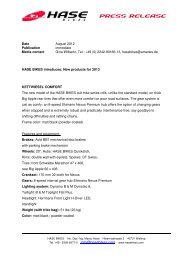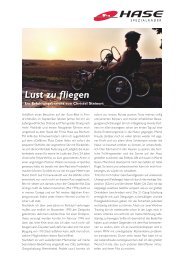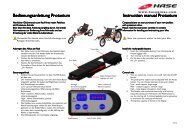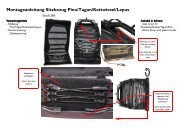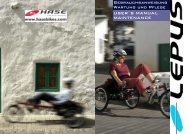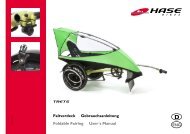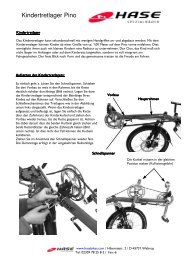Trets Mode d'emploi, version 9-09 F-ENG - Hase Bikes
Trets Mode d'emploi, version 9-09 F-ENG - Hase Bikes
Trets Mode d'emploi, version 9-09 F-ENG - Hase Bikes
You also want an ePaper? Increase the reach of your titles
YUMPU automatically turns print PDFs into web optimized ePapers that Google loves.
Prise en main et utilisation<br />
Riding your <strong>Trets</strong><br />
Vitesses<br />
Les vitesses permettent d’adapter votre effort physique au<br />
relief rencontré et à la l’allure désirée. L’Energie nécessaire<br />
à chaque tour de pédale peut être réduite en choisissant un<br />
rapport adapté. Une montée à fort pourcentage sera plus<br />
facile à gravir avec un développement court qu’avec un développement<br />
long. Un rapport bien choisi devrait toujours<br />
permettre une fréquence de pédalage supérieure à 70 tours à<br />
la minute. Cette cadence est optimale pour économiser vos<br />
force et ménager vos genoux.<br />
Le <strong>Trets</strong> et le <strong>Trets</strong> Trike sont équipés d’un dérailleur 7 vitesses<br />
(série) ou d‘un moyeu 8 vitesses commandé par poignée<br />
tournante (option). Avec un dérailleur, les vitesses se passent<br />
toujours en pédalant.<br />
2<br />
Attention !<br />
Prenez connaissance du mode d’emploi joint par le<br />
fabricant du changement de vitesses.<br />
Attention !<br />
Exercez-vous d’abord à passer les vitesses dans un environnement<br />
à l‘abri de toute circulation. Les efforts pour<br />
assimiler le maniement des vitesses pourraient détourner<br />
votre attention de la circulation.<br />
Commande par poignée tournante<br />
En tournant la poignée ( ) à votre main droite dans le sens<br />
des aiguilles d’une montre, vous passez sur un rapport long<br />
pour aller vite. En la tournant dans le sens contraire des<br />
aiguilles d’une montre, vous passez sur un rapport plus court<br />
et vous irez moins vite.<br />
Freinage (<strong>Trets</strong> Trike)<br />
De série, le <strong>Trets</strong> Trike est équipé de freins à disques mécaniques.<br />
Les leviers de freins (2) se trouvent aux extrémités gauche<br />
et droite du guidon. Le levier gauche agit sur le frein de la<br />
roue gauche et le levier droit sur le frein de la roue droite.<br />
Attention !<br />
Les freins à disques du <strong>Trets</strong> Trike sont très efficaces et<br />
très progressifs. Néanmoins, un blocage des roues peut<br />
survenir. Faites avec votre enfant des essais de freinage<br />
hors de la circulation.<br />
2<br />
Shifting<br />
Shifting gears allows you to adjust pedaling strength to the<br />
terrain and desired speed. The force required per pedal revolution<br />
can be decreased by selecting the appropriate gear. In<br />
this way, it is much easier to ride up a steep hill in a lower<br />
gear than in a high gear. In a lower gear, however, you are<br />
slower and have to pedal faster. High gears are best suited<br />
for riding at higher speeds on flat terrain or riding downhill.<br />
Select a gear that allows you to pedal at more than 70 pedal<br />
revolutions per minute. This cadence is optimal for producing<br />
sustained power and preventing excessive strain on the knee<br />
joints.<br />
In its standard <strong>version</strong>, the <strong>Trets</strong> is equipped with a 7-speed<br />
derailleur system or optional with 8-speed internal gear hub<br />
with twist shifter. With derailleur systems, the gears can only<br />
be shifted when pedaling.<br />
Caution!<br />
Please note the information provided in the enclosed<br />
manual from the gear system manufacturer.<br />
Caution!<br />
Before riding the Kettwiesel on public roads, be sure to<br />
familiarize yourself with gear shifting in an open area<br />
away from traffic. Shifting gears takes practice, which<br />
could distract you from navigating road traffic.<br />
Shifting gears with the twist shifter<br />
Turn the twist shifter ( ) on the lower right grip clockwise to<br />
shift to a higher gear for faster riding or counterclockwise to<br />
shift to a lower gear for slower riding.<br />
Brakes (<strong>Trets</strong> Trike)<br />
All standard model <strong>Trets</strong> Trikes are equipped with mechanical<br />
disc brakes. The brake levers (2) are mounted on the left and<br />
right grips of the handlebar. The left wheel brake is controlled<br />
with the left brake lever, and the right wheel brake with the<br />
right brake lever.<br />
Caution!<br />
The disc brakes of the <strong>Trets</strong> Trike are very powerful and<br />
have good modulation. However, it is still possible for the<br />
wheels to become locked. Before riding the Trike on public<br />
roads, be sure to familiarize yourself with the braking<br />
force by trying a few braking trials in an open area away<br />
from traffic.<br />
<strong>Trets</strong> 9/<strong>09</strong>-F-<strong>ENG</strong>





